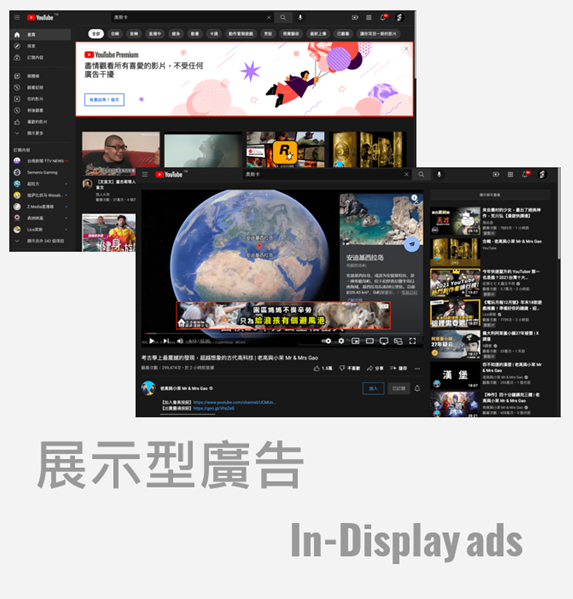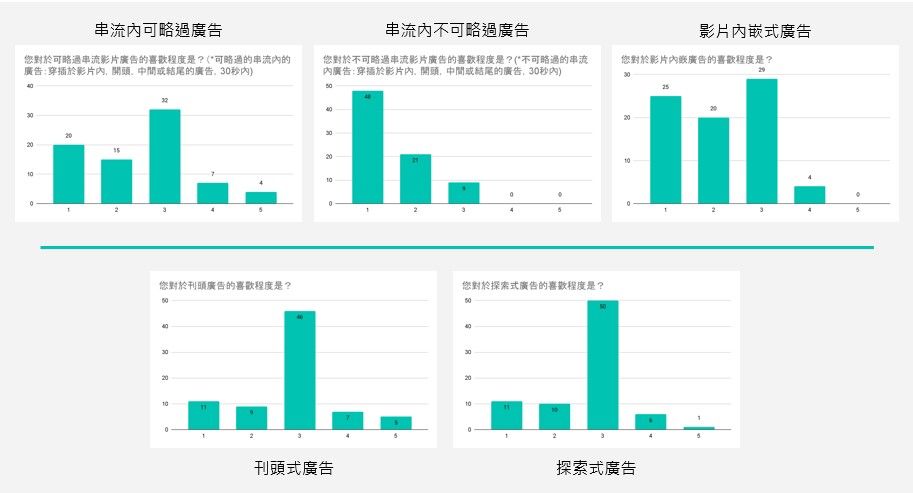📝📝: YouTube ads dead again?

In the research methods course in the last semester of my junior year, we did some research on YouTube advertisements, mainly investigating the viewers' viewing and click intentions on advertisements. This article is an excerpt from the research case. We conduct surveys through questionnaires from 2021/12/31 to 2022/01/04. The total number of recovered questionnaires: 113, the number of valid questionnaires: 112
Here, a brief introduction to various advertising proper nouns is given.

Introductory video ads are placed before users watch the video and can be subdivided into
Skipable in-stream ads (In-Stream ads. Within 60 seconds, skippable after 5 seconds)
Unskippable in-stream ads (In-Stream ads. Within 15 seconds, 5 seconds later still unskippable)
Bumper Ads (Bumper Ads. Can't skip ads within 6 seconds)
╴

Display ads can be subdivided into
Masthead (YouTube Masthead)
In-Video Banner
Mastheads are placed above the YouTube homepage; InVideo Ads are placed in the middle of the video and below the video.
╴

Discovery ads (TrueView Discovery) are commonly found in three places, namely video search page recommendations, YouTube homepage, and the right-side recommended video wall interface.

In this questionnaire, the Likert scale is used as the analysis basis, and each question has five options to answer, namely:
1: very disgusted
2: a little disgusted
3: Normal
4: a little love
5: I love it very much

The advertisements appearing in the video will make the respondents have a high degree of disgust, so the bar graph will be tilted to the left (the farther to the left, the higher the degree of disgust) . Among them, "can be skipped or not" as the classification criteria can be divided into two categories. They are "Unskippable In-Stream Ads" and "Skipable In-Stream Ads" and "In-Video Ads". Non-skipable ads will make viewers have the most rebellious psychology, so the most respondents are disgusted by it (48 people), and among the categories of ads that can be skipped, the degree of disgust caused by embedded ads is higher than that of skippable ads. The number of streaming advertisements is high (25 people, 20 people), which will cause this difference because the embedded advertisements all jump out in the middle of watching the video, depriving the viewers of the original immersive atmosphere, thus creating a reverse psychology.

Ads that appear outside the intended video are less annoying to viewers because they don't directly interfere with the viewer's viewing process ; therefore, mastheads (when viewed on a computer, Appearing on the top of the homepage) and exploratory ads (when viewed on a computer, the ad will appear in the recommended column on the right side of the video), both of which are less psychological than the ads that appear in the video.
In the field of advertising research, it is often said that "the death of the first advertising" was the first TV recorder (occasionally called a digital set-top box when it was introduced to Taiwan), which was introduced by the American digital video and audio company TIVO. Users can record the TV program they want to watch and watch it. If they encounter an advertisement in the middle, they only need to skip or fast-forward. In the subsequent development of advertising, as long as new media appear, advertising will basically be declared dead again; for example, the Internet, YouTube, social media, online video streaming platform (OTT)...... .Wait. However, businessmen and ad pitchers will also make a comeback, with new types of ads continuing to appear in front of viewers, and YouTube ads in digital advertising are arguably the most ill-fated.
Since 2007, after YouTube opened the function of placing advertisements on the website, some merchants have tried to place advertisements on this emerging online platform; however, at this time, the merchants still made advertisements with the thinking of TV advertisements, and the effect is of course Not very good [1]. In 2009, YouTube offered seven different ad formats to choose from, and in October of the same year, the official computing site had over one billion daily views. In December of the same year, "AdBlock", a web ad blocking software, was released, which also allowed it to be added to Google Chrome's web extensions. By 2010, the number of advertisements on YouTube had been nearly ten times higher than the previous year[2], and businessmen were also racking their brains to create new advertising formats and content, trying their best to compete for the valuable attention currency. .
In the middle of this research case, I found that YouTube's update released new features, and this new feature release can be said to make YouTube advertising dead again. This feature is that you can play the video without clicking on it. The page of the mobile phone board only needs to place the video on the current screen to play it automatically, and the page of the computer version can automatically play the video by placing the mouse cursor on the top of the video; more importantly, watching the video in this form will not play at all. Users can also manually adjust the volume, subtitles, and video progress even if there are ad distractions .


The update of this feature is undoubtedly a big blow to ads that need to be clicked into the video to jump out (eg skippable ads, non-skippable ads, inline ads). If the user does not click on the video, the merchant cannot profit from the number of clicks and analyze the viewing behavior; however, the user can watch the entire video, and is not afraid of encountering an advertisement that suddenly hijacks the eye during the viewing process.
How can attention merchants survive this function? I'm looking forward to seeing YouTube advertising take off again in a more innovative way to the more varied YouTube platforms of the future.
╴
References:
[1] Mark Sweney. (2007). First ads appear on YouTube clips . The Guardian. Retieved from: https://www.theguardian.com/media/2007/aug/22/advertising.digitalmedia
[2] Nicholas Jackson. (2011). Infographic: The History of Video Advertising on YouTube . The Atlantic. Retieved from: https://www.theatlantic.com/technology/archive/2011/08/infographic-the-history- of-video-advertising-on-youtube/242836/
TiVo digital video recorders. Retrieved from Wikipedia: https://en.wikipedia.org/wiki/TiVo_digital_video_recorders
AdBlock. Retrieved from Wikipedia: https://en.wikipedia.org/wiki/AdBlock
He Yuanqiong, Tang Yangyi, Zhang Junfang (2016). Research status and prospect of consumer psychological reversal. Retrieved from: https://qks.sufe.edu.cn/mv_html/j00002/201602/f70d0159-72bf-4835-a542-a3f0a309a561_WEB.htm
Like my work? Don't forget to support and clap, let me know that you are with me on the road of creation. Keep this enthusiasm together!

- Author
- More